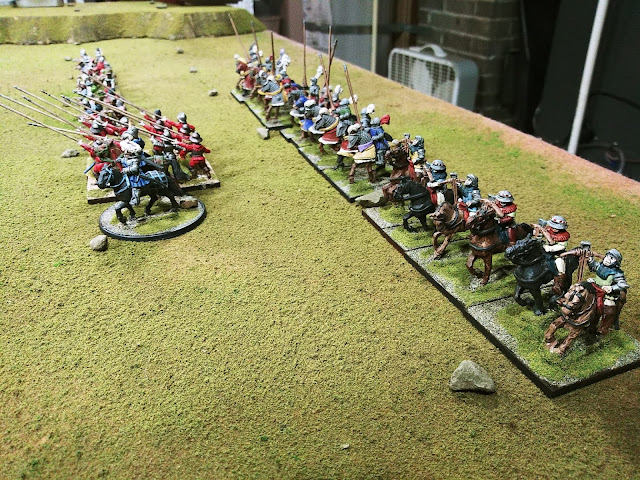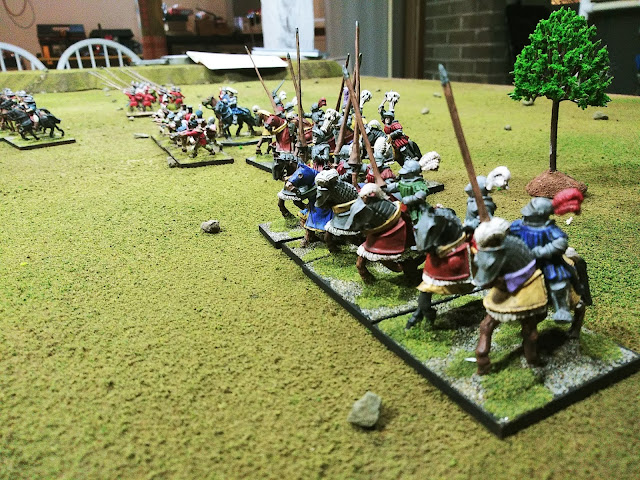Next up in the Alamannic Invasion of 366 was the decisive battle between Jovinus and the Alamanni near Chalons in 366 (not to be confused with another battle in same area in 451). The Romans were outnumbered here, but Jovinus deployed across the valley in such a way to trick the Alamanni into thinking the forces were more evenly matched. The Alamanni eventually realized the deception and advanced. After a long day of hard fighting, the Romans emerged victorious. I used the same force compositions from the previous game but added to the Alamanni the three Gothic cavalry units I had just finished painting a few days before.
 |
| Freshly recruited Gothic cavalry supporting the Alamanni. |
This pitched 13 Alamanni units against 10 Roman ones. I meant to class all the Roman heavy infantry as Elite (which in The Portable Wargame only increases likelihood that they will have the option of falling back and not losing a SP) but I completely forgot to implement this, although I don't know if it would have made a difference. I did use the card-draw method of activation suggested The Portable Wargame. You divide the number of units in each army by two and round up, then take all the cards in one color equal to that number, plus all the cards one higher and one lower, and put them in a stack. So for the Romans, they had 10 units, so their activation deck had two each of red 4, 5, and 6. The Alamanni (decisively, perhaps) had two each of 6, 7, and 8. A joker is also in the deck which will reshuffle the deck. I should have bumped all the Roman cards up at least one (so, 5, 6, and 7) to represent Jovinus' good generalship during the campaign (and perhaps one more so as to be even with the Alamanni, to reflect high morale at the end of a successful campaign).
 |
| Late Roman heavy infantry and close-order archers. |
 |
| Starting positions, Romans at bottom. Bits of rock from paver base are used to mark the grid. |
As things played out, the Alamanni had 4 of the first 5 activations (6, 6, 8, 7 respectively) and were able to bring a mass of six heavy infantry (in two lines of three) across the table in quick order. The front line softened up the Romans with short-range missile fire (throwing axes and javelins and such), and the second line then charged through the first line and engaged in melee.
 |
| The Alamanni are able to occupy the middle of the field quickly... while the Roman line has only barely advanced from its starting positions... |
 |
| Romans brace for the charge... |
 |
| There is a gap in the Roman center, and lost SP markers accumulating along the rest of the Roman line, while almost the entirety of the Alamanni host advances. |
 |
| The Alamanni attack along the entirety of the Roman lines. |
Laying out casualties across the Roman line and creating a gap in the center, the rest of the Alamanni host advanced, including the cavalry. As the Alamanni infantry attacked, the Roman heavy cavalry attacked the Alamanni's Gothic cavalry. This cavalry battle went back and forth, but in the end the Romans took the worse of it. The Romans did not fare much better in the infantry fight, and the Romans suddenly found themselves on the brink of their exhaustion point (I like how this moment creeps up on you in
The Portable Wargame).
 |
| And most of the Roman lines are pushed back. |
 |
| Roman lines fall back to their starting positions, with exception of some flank units. |
After an army hits its exhaustion point, it cannot take offensive actions anymore, nor move towards the enemy. Anticipating a defensive battle, the Romans attempt to dress their lines by aligning roughly at their original starting positions.
 |
| Romans have hit their exhaustion point. Roman right flank falls back in line with the rest. Roman left flank is attacked by Alamanni foot and cavalry in turn. In the bottom right is extremely beat up Roman cavalry. |
The Alamanni, meanwhile, are just shy of their exhaustion point. They have clearly won control of the field. They exchange short range missile fire, move the rest of their foot up the field, and launch a flank attack on an isolated Roman unit stuck out by itself.
 |
| Isolated Roman infantry on the left under attack. |
 |
| Jovinus holding the Roman line. |
 |
| Cavalry engaged with isolated Roman infantry on the left. |
 |
| Isolated Roman infantry on the left under attack. I've recently started snipping off dracos, replacing the pole with steel wire and then drilling out and mounting the metal windsock on that. Much more durable and you can get an extra mm or 2 of height on the pole which looks smart. |
In the end, the Romans get a round of decent shooting attacks off from one end of the line to the other, and trip the Alamanni over their exhaustion point. The game is now over.
 |
| Endgame. Both sides have reached exhaustion points. |
I was going to award victory points for control of the field, which the Alamanni easily won in terms of having moved their entire army across the half-way point of the field. However, both sides had only lost a single unit, and the Romans still securely held their original positions. If the fighting had stopped for the day, one could imagine either or both of the armies slipping away under cover of night. Probably a draw then.
I don't know if I'll use the card draw system again. The higher number of activations possible for the Alamanni, combined with a strong run of draws at the very beginning of the game, gave them a big head start at the beginning of the game - the Alamanni were able to attack in depth (cool to see that actually work, though) and the Romans were on their heels the whole game.
What is clear is that I need some better defined victory conditions or scenario goals for games using The Portable Wargame, which itself only tells you when a game ends (when both sides have reached their Exhaustion Points, which is 1/3rd of their total SP). Personally I prefer abstracted VP which reward players for being in control of the field strategically, and less so causing more casualties (although I use that metric as well). Flipping through many of my other rulebooks, winning a game is heavily dependent on removal of units, which does not fit well for The Portable Wargame, where unit removal seems to be rare (in two games played, only one unit per side been actually destroyed each time).
I am still enjoying the abstraction and speed of play with these rules. And I think most wargamers would agree that its more fun when almost all units tend to stay on the table for the entire game!




















































